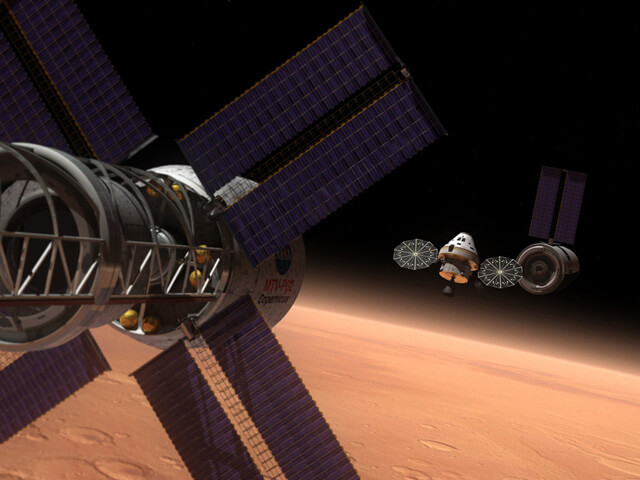The new spacecraft, known as Multi-Purpose Crew Vehicle - MPCV, will be able to fly a crew of four people for a period of 21 days and will land in the Pacific Ocean

NASA has reached an important milestone in the development of the next US transport spacecraft that will carry humans into deep space.
NASA Administrator Charles Bolden announced on May 25, 2011 that the system will be based on designs originally planned for the Orion crew vehicle. These plans will now be used to develop the new spacecraft, known as the Multi-Purpose Crew Vehicle (MPCV).
"We are committed to manned research beyond low Earth orbit and look forward to developing the next generation of systems to take us there," Bolden said. According to him, the approval of the NASA law gives the agency a clear horizon by handing over transportation to the International Space Station to partners from the private sector so that we can focus on deep space exploration. While we continue to work hard on developing strong launchers, we are also moving forward within an existing agreement to continue on the path of developing a crew vehicle."
Lockheed Martin will continue to work to develop the MPCV. The spacecraft will carry four astronauts for missions of up to 21 days and can land in the Pacific Ocean off the coast of California. The spacecraft will have a volume of about 20 cubic meters, of which about 9 cubic meters of living space. It is designed to be 10 times safer during ascent and entry than its predecessor, the space shuttle.
"This selection does not indicate a business-as-usual mentality for NASA programs," said Douglas Cook, NASA's assistant administrator for manned systems research at the NASA Directorate in Washington. "The joint team of government and industry has demonstrated extraordinary creativity in finding ways to keep costs low through management techniques, technical solutions and innovation."
An area dealing with the development of the MPCV on the NASA website

13 תגובות
A very strange decision indeed.
Why do we need manned flights into deep space?
The manned flights burn a huge amount of money on safety, food and returning the crew to Israel.
Unmanned spacecraft are much lighter and more compact and allow for maneuvering
Budgets for scientific research.
The conclusion is therefore that the consideration is political-psychological.
Apparently, much more budgets can be "squeezed" for manned flights than for scientific research.
L: From someone else entirely
You wrote in your response: "....in the journey to Mars they are guaranteed not to return.
You can send "martyrs" to this mission..."
From your words it can be concluded that you are ready to abandon the holy territories
Mars in the hands of radical Islam.
is that so ?
I wanted to ask you if anyone has any idea about tr3b (a lot of information on Google)
Because if this is true then NASA is laughing at us.
And I wonder why
to 9 In the "Apollo" missions they were not guaranteed to return.
On the journey to Mars, they are guaranteed not to return.
You can send "martyrs" to this task,
But in the existing circumstances, transportation capacity
(vehicles, laboratory facilities) and low survivability,
The journey is not worthwhile even from a research point of view
- and it doesn't matter how much you spend. one missile
who will have to overcome the earthly attraction
It just won't take everything and two missiles (one per team
one per load) require a complex operation
That it will not be possible to have no vehicles, devices
And enough staff.
to 7 -
In any case there is no real competition for NASA... look at what the race to the moon did. In my opinion, once there is a race to Mars, it will happen within 10 years. A technological structure has the majority and what is not then they can develop if there are budgets.
You just need lots and lots of money and 3 volunteers who will be willing to give their lives for the cause (as in the flight to the moon they were not guaranteed to return).
When will they build an elevator to space?
To 6.
I know it sounds like science fiction but a trip to Mars will
Much more likely after they start assembling ships in orbit
around the earth or the moon (like the space station is made up today
the international).
A trip by ship that will leave Israel directly to Mars will take about six months
And it will be simply unbearable for the astronauts - not to mention
That they probably won't be able to come back.
In any case, it will take a long time for humans to reach Mars.
The problem of the USA is that there is no space race like in the 60's, therefore NASA hardly receives budgets and works slowly...
I hope that China and India will give NASA a fight and that way everyone will move their asses to Mars as soon as possible.
It is sad that after so many years the conditions of the astronauts have not changed and they will continue to crowd in flying sardine boxes, under terrible overcrowding conditions
I wish. I wish to wish some more
Any technological progress is for the better
Someone forgot their meds I guess? 🙂
Maybe in the future it will also be possible to send all kinds of Hitlers and bin Ladens on these spaceships.
Instead of killing them, or other 'serious' criminals, it will be possible to send them into space (with a 'one way ticket') - and there they will work for the scientists, and also be able to contribute something to humanity.
In this way, we will not have to kill such creatures (and it might contribute something to human morality for future generations).